Amersham, Buckinghamshire
[Up to 1834]
[After 1834]
[Staff]
[Inmates]
[Bibliography]
[Links]
In 1725, the early workhouse directory, An Account of Several Workhouses..., notes the existence of a workhouse at Agmondesham — an old spelling of Amersham.
A parliamentary report of 1777 recorded parish workhouses in operation in Amersham (for up to 75 inmates), Beaconsfield (40), Chalfont St Peter (80), and Chesham (90). Chesham's workhouse was located on Germain Street and the building was later used by Chesham Grammar School.
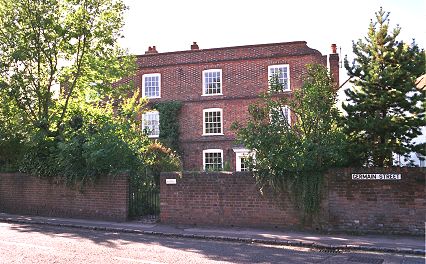
Chesham former parish workhouse, 2003.
© Peter Higginbotham.
After 1834
Amersham Poor Law Union was formed on 25th March 1835. Its operation was overseen by an elected Board of Guardians, 14 in number, representing its 10 constituent parishes as listed below (figures in brackets indicate numbers of Guardians if more than one):
County of Buckingham: Amersham (2), Beaconsfield (2), Chalfont St Giles, Chalfont St Peter's, Chenies, Chesham (3), Chesham Bois, Penn, Seer Green.
County of Hertford: Coleshill.
Later Additions: Ashley Green (from 1897), Chartridge (from 1899), Great Missenden (from 1838), Latimer (from 1899), Lee (from 1838), Little Missenden (from 1901).
The population falling within the Union at the 1831 census had been 15,331 with parishes ranging in size from Chesham Bois (population 157) to Chesham (5,388). The average annual poor-rate expenditure for the period 1832-35 had been £11,520 or 15s. per head.
In May 1835, just two months after the union's formation, the inmates of the Chesham parish workhouse were being moved to Amersham. (To where, exactly, is unclear as a new union workhouse had not yet been built.) The removal operation was obstructed by a large crowd with a local magistrate being assaulted and the Riot Act read. The subsequent trial of some of those involved was the subject of a lengthy report in The Times on July 4th, 1835, of a which an abridged version is given below.
AYLESBURY, JULY 3.
TRIAL OF THE CHESHAM RIOTERS.
Daniel Stone, George Benning, Henry Haycock, William
Price, Daniel Brown, Mary Butterfireld, aged 37, Ann Price, aged 18, Charles Purrott, and David Morgan, were indicted for having obstructed the removal of paupers from Chesham to the Union workhouse at Amersham, and with having dragged the paupers out of the waggon. They were also charged with having beaten, assaulted, and wounded Mr. Fuller, the magistrate.
Mr. Fuller was the first witness, On the 23d of May he attended at the Chesham workhouse to superintend the removal of the paupers to Amersham and to see that no improper persons were removed. About 100 persons collected on the outside, and he was received with hissing, hooting, and yelling. Witness went out to remonstrate with them. Mr. Lowndes, another magistrate, also went among the crowd, and endeavoured to prevail on them to be peaceable, but they paid no attention to the remonstrances. The gates of the workhouse were opened to bring out the waggon, but the crowd rushed up and said "Don't let them come out," and closed the gates. Witness then read the Riot Act. He saw Purrott and Stone actively engaged in the crowd. They rushed up with the people and assisted in losing the gates. After the Riot Act was read, the crowd gave way and allowed the waggon to come out. Witness followed the waggon, and a great crowd also followed, mostly women and lads. At the end of Amy-lane, through which the waggon passed, some stones were thrown, and violent language was used. The women excited the men, calling them cowards, and said "the men of Chesham had no spirit, or they would not suffer the poor people to be taken away." At Amy-mill the wagon was stopped: the driver struck the people with his whip, and insisted that the waggon should go on. The waggon then again went on, and the people followed. As it was going up the hill stones were thrown, some of which struck witness. Someone put the drag under the wheel and prevented the waggon going up. At the Mill the crowd called out to the paupers, when the waggon was stopped, "Get out. Why don't you get out?" The paupers refused to get out and one who was sitting at the tail of the waggon drew out a knife and threatened to cut off the hand of anyone who approached. On the hill they took the tail board of the waggon out. He saw Purrott, Stone, and the boy Price then present. Benning, and Butterfireld, and Ann Price he afterwards observed near the same spot. Stones were flying in showers, and the witness was struck by several of them. The crowd threw stones under the wagon to disable the horses, and some over the waggon. Witness left the waggon for a short time, and the crowd then followed it more actively than before, and pulled one of the paupers out at the side of the waggon. Witness again followed. On Chesham-common witness found the man lying on the ground who had pulled out his knife with his hand cut with a stone. Further on he found one of the forms, which had been taken out of the waggon, and broken. He observed that the waggon was empty and the crowd were bringing the paupers back in carts. Witness retreated to one side of the road to avoid the crowd but they observed him, and threw stones at him. There was a cessation of the throwing of stones for a few minutes, and Daniel Brown then came forward to ask witness a few questions. Several others came up and surrounded him, among whom were Purrott and Benning. They asked witness for beer, saying they would let him go if they gave him some, and they greatly abused him. he refused to give them any beer, saying he had no money, but they answered that his credit was good at the public-house, and they could get plenty if he gave an order. The women stood in front round him, and the men on the outside, and the men pushed the women against him, and drove him about. Ann Price was among the women. Clods of turf and stones were also thrown at him. He slided away from them, and was proceeding towards his farm, when he received a blow at the back of the head, which cut through the hat and penetrated through the flesh to the bone. In the afternoon witness then went to the workhouse at Chesham, his head was then tied up, and he was covered with blood. There were about 400 or 500 persons present, and they abused him, observing, "What a pretty figure he cuts now." Witness was so much alarmed at the conduct of the crowd that he would not go home alone.
Mr. Maltby then proceeded to address the jury on behalf of the defendants. He observed that he was instructed by the defendants to express their deep regret at the acts of violence that had been committed upon Mr. Fuller. Not one of the defendants, however, was proved to have committed that violence, but on the contrary, one of them had assisted him when he was struck with a stone at the back of the head. He hoped the jury would look with to the circumstances under which the disturbances occurred. An act had passed which changed entirely the face of things as regarded the Poor Laws, and altered the condition of the poorer classes. It was impossible to calculate the deep degree of interest that the act excited among the poor people. Even in Parliament it was most warmly opposed. When the provisions of that measure were to be carried into effect for the first time in the parish of Chesham, and when the people saw the carriage drawn out which was to separate relations from relations, and friends from friends, and to convey them to a distant town, he put it to the jury whether it was not likely to cause a very great excitement.
|
All the defendants except Henry Haycock were found guilty of riotous assemblage and given prison sentences of between 14 days and 4 months.
The new Amersham Union workhouse was built on Whielden Street at the south of Amersham in 1838. It was designed by the partnership of George Gilbert Scott and William Bonython Moffatt who were the architects of many Union workhouses including the nearby one at Wycombe. The building contract of £5,750 was awarded to a Mr Jacob of Northampton who was required to complete construction work by the end of May 1839. Jacobs went bankrupt before finishing the work and the building was completed by Messrs Page and Simpson. The workhouse was opened on 29th September 1839. Its location and layout are shown on the 1925 map below by which time it was officially known as Amersham Poor Law Institution.
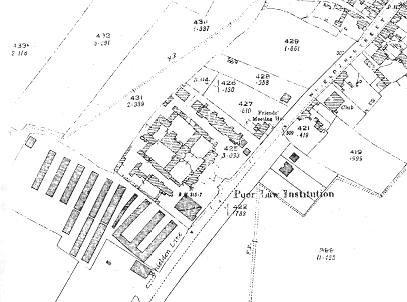
Amersham workhouse site, 1925.
The Elizabethan-style building was faced in local flint. At the south of the site, the single-storey entrance block had a central archway with the date and letters "AV" (Amersham Union) inscribed above.
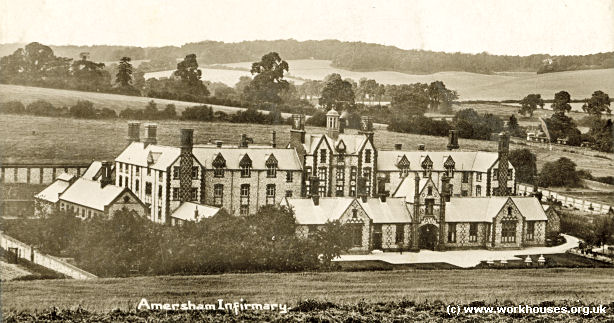
Amersham workhouse from the south, c.1905.
© Peter Higginbotham.
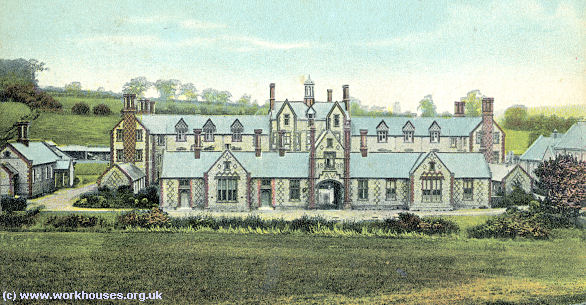
Amersham workhouse from the south-east, c.1905.
© Peter Higginbotham.
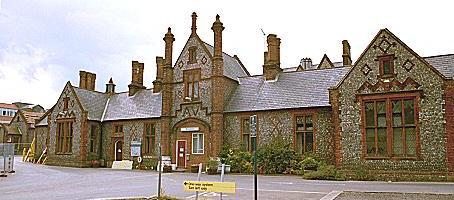
Amersham entrance block from the south, 2000.
© Peter Higginbotham.
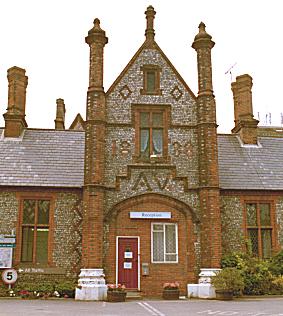
Amersham entrance from the south, 2000.
© Peter Higginbotham.
To the rear stood the three-storey main accommodation block.
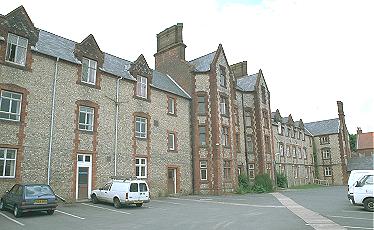
Amersham main building from the south-west, 2000.
© Peter Higginbotham.
In 1904, a new infirmary was erected at the north-east of the main workhouse at a cost of £3,400.
The site expanded considerably to the south-west, later becoming St Mary's Hospital and then Amersham General Hospital. The original workhouse building has recently been redeveloped with some demolition of the smaller buildings, including a single storey outbuilding at the west.
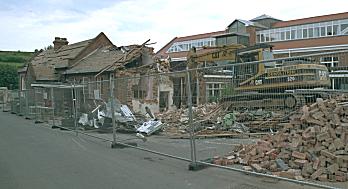
Amersham outbuilding in course of demolition, 2000.
© Peter Higginbotham.
Records
Note: many repositories impose a closure period of up to 100 years for records identifying individuals. Before travelling a long distance, always check that the records you want to consult will be available.
-
Centre for Buckinghamshire Studies, County Hall, Walton Street, Aylesbury, Bucks HP20 1UU.
Relatively few records survive — holdings include: Guardians' minute books (1837-47, 1920-25).
-
The History of Amersham General Hospital 1838-1988 by Nicholas Salmon.
[Top of Page]
[Unions List]
[Unions Map]
[Home Page]










